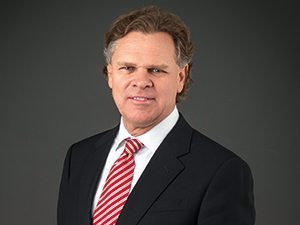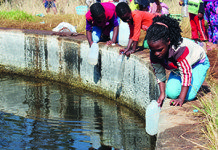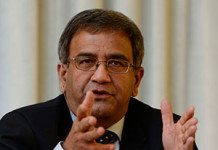
[miningmx.com] – IT PROVES HARD work finding the way to the Johannesburg offices of Waterberg Coal Company (WCC). There’s no signage. When one finally gets there, the offices are mostly empty.
Stephen Miller, CEO of WCC, looks vaguely apologetic: “We’ve just moved in. We can chat here,’ he said pointing to another office only slightly less desolate in that it has a desk and two chairs.
Colleagues of his are wiping up the newly refurbished chrome. Even the restrooms sport a plush new tile. Clearly, Miller and WCC are expecting to be busy.
Some 340km away, in South Africa’s Limpopo province, employees of Transnet, the state-owned transport and logistics company, are building a rail loop that will enable 200-wagon trains to speed straight through the province and its neighbouring Mpumalanga on the way to Richards Bay in KwaZulu-Natal province.
It will be a 940km dash for the coast linking the mineral wealth of South Africa’s interior to the Asian markets that so favour the country’s coal supplies.
It’s a job of expertise and high expense; but most of all, it’s a job requiring time.
For Miller, and Transnet, the expectation is that the time is finally right for the South African government and the private sector to grasp the nettle: there are billions of tonnes of coal in the Waterberg waiting to be dug and an even greater economic need motivating it.
Eskom is desperate for the mineral to keep the lights on after 2018; and the world export markets are beckoning if only South African can shake its legacy of political in-fighting, and its administrative lethargy.
Already, Transnet has set down the infrastructure to allow the transport of some 10 million tonnes of coal (mtpa) from the Waterberg coalfields, an enormous advance from almost a standing start. In the next three to four years, capacity will increase to 28mtpa, but it’s been a difficult journey.
“A lot of work is being done on the ground which we don’t shout about,’ said Mxolisi Mgojo, head of Exxaro Resources’ coal business. “We are beginning to see culmination of a process of engagement with Transnet and TFR [Transnet Freight Rail, its largest business unit]. They are coming up with a strategy to unlock the north-west corridor,’ he said.
According to Macquarie Research, coal is hugely strategically important to the country.
Annual production is about 260mt most of which is used to generate about 90% of South Africa’s electricity.
The exploitation of coal fields has made South Africa the world’s fifth largest exporter as domestic reserves of coal have opened up exportable ones.
As a result, the coal sector contributes 3% to South Africa’s gross domestic product and 6% to export revenues, making it the third most important mineral after gold and iron ore.
“Notwithstanding the significant remaining economic resources, growth of the [coal] industry is challenged by uncertainty around Eskom demand, rail infrastructure, potential regulatory intervention and funding,’ said Macquarie Research in a note earlier this year.
It believes that in the best case scenario, domestic power station demand will increase to 178mtpa and exports to 88mtpa by 2030 of which about 40% will be derived from the Waterberg.
If no new coal-fired power generation is developed then exports would be only 76mtpa with only 118mtpa going to the power stations. The Waterberg’s contribution would be only 20% of the total or 43mtpa.
Either way, the work on the Waterberg infrastructure to date seems justified. The Witbank coalfields are slowly being exhausted, although as we show below, they are not without pockets of value, and new sources of coal have to be found. It’s why Eskom is trying to sign up coal from valid, qualifying coal producers in the Waterberg.
BIG DEAL
According to Miller a coal supply agreement currently under negotiation between WCC and Eskom, the South African power utility, may become the benchmark for the majority of coal supplied from the region.
WCC controls the Waterberg Joint Venture, a two billion tonne thermal coal prospect in the Waterberg coalfields. Miller said Eskom and his company hoped to turn a memorandum of understanding on the supply of 10mtpa into a 30-year offtake agreement.
The coal will supply Eskom’s Majuba power station starting from the third quarter of 2015. Miller did not expect any slippages in the timetable.
“We need to develop a take-or-pay deal with Eskom for 30 years. They see it as a conditional agreement already,’ he said.
Interestingly, Eskom was seeking a high quality thermal coal equating to RB2 (6,000kcal/kg) or RB3 (5,500kcal/kg) specifications. ” They are looking for 30% ash content, and about 1.2% sulphur. These are the quality drivers,’ Miller said.
He added that he didn’t expect Eskom to agree to pay export parity. “The reference point will be the cost of importing the goods,’ he said. The contract arrangement was not a traditional cost plus deal as WCC was providing all the capital, and would take a market-related price for the coal, he said.
However, the coal would be supplied from mine gate with Eskom responsible for transporting the material to Majuba.
“What they do with us may become a benchmark for the Waterberg,’ said Miller. “We are what Grootegeluk [the Exxaro Resources mine] started with some 25 years ago.
“We have more export quality coal in our resource today than any other company in South Africa; it’s in excess of 1bt in the mining resource category. We have grown the project significantly over the 18 months,’ he added.
Finalisation of the price and quality specifications were expected to be completed in the four to six weeks. “There’s a sense of urgency on both sides. They need to plan for Majuba; we need to have confirmation of final price which is the input into the final economic model for the mine,’ Miller said.
Total capital required to build the 10mtpa mine has been estimated at between $500m to $550m which makes the project in line with the scale of the other Waterberg-based coal project, Boikarabelo which is being developed by Resource Generation (Resgen).
Unlike Resgen, however, Miller expects WCC will acquire its finance relatively easily.
“The due diligence process by the potential funders did not start on time, so we have two months of slippages,’ said Miller in April. “But by the end of the second quarter [June], we hope to have the funding package bolted down,’ he said.
“That means we will have completed the term sheets from the banks and have the credit approved. In the current market, the funders are more diligent than before,’ he added.
Of the total $550m in capital, about $350m would be in debt with the balance in equity finance. Possible equity finance could come from a black economic empowerment company but Miller said there weren’t many new entrants that could “sign a cheque’ for $200m.
What’s not required of WCC is 50% plus one share empowerment as its agreement with Eskom pre-dates recent legislation in South Africa that requires new suppliers of coal to the power utility to be black-controlled.
Anglo Thermal Coal is currently locked in a dispute with Eskom in which it is argued that Anglo’s Inyozi consortium must increase its BEE involvement in the proposed New Largo mine to 50% plus a share from 27% now.
Miller said Sekoko Resources, its empowerment partner, has lowered its involvement in the Waterberg Joint Venture to 30% from 40%, which is held at the project company level, but that this is sufficient to meet 26% empowerment as set down in earlier mining legislation.
Miller created WCC from Range River Gold, an Australian cash shell that bid for control of the Waterberg Joint Venture from Firestone Energy, a Johannesburg-listed company. The takeover was somewhat acrimonious with Firestone directors saying Miller’s offer ought to be in cash, not shares, and at a premium.
In the end, WCC settled for 45% of Firestone which meant that the Waterberg Joint Venture was jointly owned by two separately-listed companies.
Miller said, however, that a “consolidation’of the interests was inevitable. “It is logical that there be a consolidation of structures in the near-term,’ he said.











